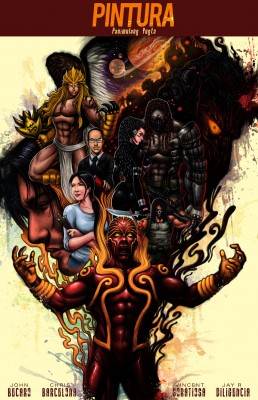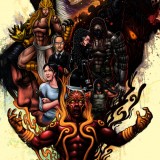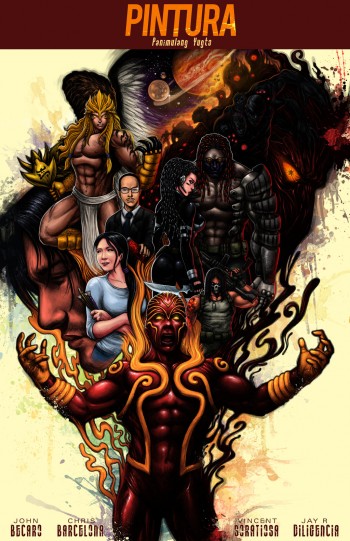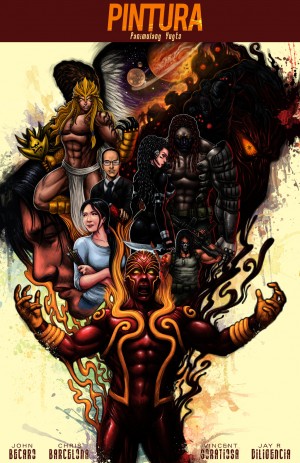
Philippine indie comics continue to gain momentum these past years. This is significant due to the fact that many of our co-patriots who possess artistic endowments and potentialities can either pursue their dreams as artists or simply, enriching/enhancing our Philippine mythology to the next level. In last year’s Komikon alone, there was a wide independent Pinoy comic selection to choose from that most probably in the future, these works and artists become the successors of Filipino artistic greats like Francisco Conching, Larry Alcala, Tony Velasquez, Jess Abrera and even Lan Medina! One of these is Pintura: Panimulang Yugto by the foursome John Becaro, Chris Barcelona, Vincent Soratiosa and Jay-R Diligencia, and under the editorial eyes of KC Cordero.
The cover arts already show the great possibilities the creative team possesses for the apparent tone and theme of the main story would be gritty, dark and, homage to several pop cultural references. And, this book is very compact! Virtually every page (even the cover pages) is packed with visual and literary treats, and this is way evident in the main story itself—dense, full of dialogues and thought balloons.
Speaking of the text applied here, it is a heartwarming experience that Becaro utilizes both English and/or Tagalog/Filipino to show that this work is for the greater demographic, and obviously, showing the love of almost anything Pinoy patriotism. I must admit that I read and write English more comfortably than Tagalog due to my bourgeoisie educational upbringing until I entered in a state university somewhere in Manila; but that doesn’t mean my “makabayan” spirit diminishes, particularly in comics. This work proves that whatever tongue utilizes, as long as it has Philippine sensibilities and flavor, being a patriotic artist(s) is just fine alright. Moreover, we can determine easily how the linguistic texts juxtaposed and applied that distinguished the characterizations of the protagonists/antagonists and other characters involved. If straight they speak straight English and/or solid-deep Tagalog, they are basically either from the upper-middle to upper classes (educated in prestigious institutions like UP or just being privileged); while contemporary Tagalog-level and even Taglish are implied to be, well, just like any Juan and Marias out there.
True to its subtitle, this is an ambitious project to wet our appetite for more stories to come. The elements of the superhero genre are so apparent—action-packed battles, unusual monikers, exaggerated costumes/imageries, the “perfect” anatomical proportions of both male and female main characters, and of course, super abilities (seriously, I imply that the creators love reading and found inspirations from Spawn, Haunt and any superheroes whose powers are ultra-fast regenerative abilities, like Wolverine, Carnage and Deadpool!). Yet, Pintura is also a continuation of celebrating and highlighting pre-colonial practices that the influential Trese series started, popularized and institutionalized. When the main character named Juan Mag-Ingat (how makabayan!) heard voices, ancient Philippine texts known as baybay (not alibata!) are presented in great calligraphic form. And, famous mythological beings and Tagalog words are either referenced or as being the names of their respective aliases, like Talas, and Baris.
The creators set immediately the pace by cramming the essentials of a good chapter—a bewildered and reluctant hero, having a loved interest, an interesting past, a couple of foreshadowing, invisible hands/movers that may or otherwise contribute to a larger narrative to come, intriguing supporting hero castings, and some good smashing takedowns. Naturally, the team left some teasers for the next chapter if ever the readers hook up this ambitious undertaking. We can see that the overall timeline for the moment covers four years that pretty much explained how the main character got the superpowers and how the entire conflict originated.
However, I must say that perfection is unattainable. I only fully comprehend this patikim only reading a couple of times perhaps due to the preferred shadings and contrasts that are a bane to my eyes. Consistency matters whenever using black-and-white color palettes and/or more so, the grayish type. However, there are pages that the unevenness of dark and shades is so glaringly highlighted that may affect both the visual balance of the art itself and even the readability of the texts themselves. Upon my first browsing, I got immediately confused on how to distinguish the main protagonist’s past and present situations due to the sameness of the shading and the black-and-white visual continuity until I had to read the very small texts slowly and unexcitedly. Additionally, the art progressively becomes uneven and the inconsistencies of artists’ styles are very obvious to the point of we can possibly distinguish which is one creator’s style to another. And, there are some pages that are so crammed with plenty of painstaking details that I have this feeling the creators are doing this Grant Morrison-esque theme for future stories/references to come, if ever. It is the narrative or Becaro’s writing style that makes the overall story fits the visual mambo jumbo feast. I hope future chapter(s) can rectify these artistic difficulties. Thus, I advise readers to read at a moderate pace or do some rereading to fully grasp the creators’ primary vision.
I first saluted the author’s choice of tongue, and he knows his languages to the extent that his Filipino/Tagalog reminds yours truly of the old Tagalog sentence construction and syntaxes the older Tagalog speakers and writers used to conserve and write with. However, this same strength may wear many present-day Filipino/Tagalog readers (don’t forget also there are many Pinoy intellectuals and/or readers in many parts of the Philippines still prefer English than Tagalog as the medium) due to the feeling of anachronistic the words/terms/constructions used. In other words, there are at times the wordings in the thought balloons are spoken in an academically manner or in almost Balagtasan-fashioned. Or in some instance, this sense of unnaturalness or awkwardness emerges when rereading some of the dialogues. And my final curiosity emerges that still lingers is creator’s choice of title and the superhero’s name/alias. No offense here, I find it a bit humorous. One may argue that superhero names should be exaggerated or reflected to his/her abilities, to say the least. If that’s the writer’s choice since the beginning, then so be it. I hope future stories and the visual may improve so that I can enjoy how our artistic mala-Carnage-na superhero unravels the nasty truths behind his transformations.
Despite of the relative glitches I mentioned here, Pintura succeeds readers for more chapters to come. The story is convincing, the hero’s characterizations and motivations are believable, the antagonists are credible, and the plot twists are manageable. This is only the beginning of a bigger narrative to come, similar of the experiences we witness in reading Trese, Kiko Machine and other successful indie comic anthologies/series—I see improvements, refinements and confidence here in crafting grittier (and funnier) stories and some socio-cultural-political commentaries and references to reflect the zeitgeists of our times.




















